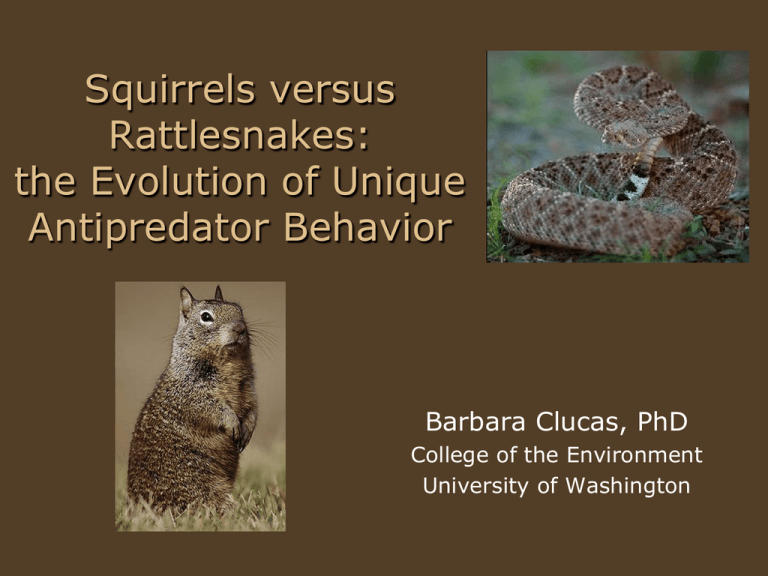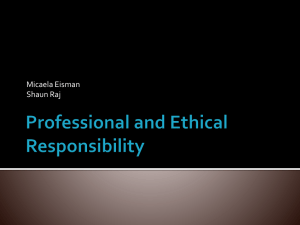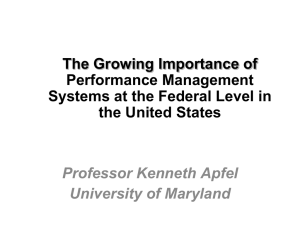
Squirrels versus
Rattlesnakes:
the Evolution of Unique
Antipredator Behavior
Barbara Clucas, PhD
College of the Environment
University of Washington
Animal Behavior
• The study of how animals
use behavior to survive
and reproduce
• How and why
behavior evolves
• Social, reproductive,
movement, antipredator
Animal Behavior
• The study of how animals
use behavior to survive
and reproduce
• How and why
behavior evolves
• Social, reproductive,
movement, antipredator
Antipredator Behavior
• Reduce the risk of
predation
• Most animals are prey
• Evolution of a vast
array of antipredator
behavior
Antipredator Behavior
Ground Squirrels
(Spermophilus)
• Diverse genus of
species
• Worldwide
distribution (except
Australia and Antarctica)
• Live in burrows in
the ground
• Species vary in
habitats and sociality
Ground squirrel predators
Ground squirrel predators
Rattlesnakes
• Warning rattle
• Venomous
• Skilled rodent predators
– Lethal venom
– Acute sense of sight and
smell
– Pit organs can sense
temperature changes
(Crotalus)
rattle
Ground squirrel defenses
• Venom resistant
• Harass, attack
rattlesnakes
• Tail-flagging
– visual and infrared
signal
Rattlesnakes are still predators…
• Ground squirrel pups
– Not large enough to be
venom resistant
– Anti-snake behavior not
fully developed
– Depend on adults for
protection (especially
their mothers)
Recent discovery
• Another unique snake-related
behavior found in certain species
of ground squirrels
• “Snake scent application”
Snake Scent Application
Snake Scent Application (SSA)
1. Why are squirrels applying
rattlesnake scent?
• Test 3 functional hypotheses
2. Evolutionary history
• Phylogenetic comparative methods
Functional hypotheses of
SSA
1. Antipredator
2. Social
3. Ectoparasitic defense
1. Antipredator
• SSA disguises
squirrel odor
– Rattlesnakes
may bypass
burrows with
snake-scented
squirrels
2. Social
• Conspecific
deterrence
• SSA deters rivals
– Snake-scented
squirrels win more
aggressive
encounters
3. Ectoparasite defense
• SSA reduces
fleas
– Flea host-finding
behavior affected
by snake scent
Testing hypotheses of function
• Study 1: Time spent applying
snake scent
– Which squirrels apply more?
• Study 2: Series of experiments
directly testing targets
– What are the effects of snake scent?
Study 1:
Which squirrels SSA more?
Study species
• California ground squirrel,
(S. beecheyi)
– Winters, California
• Rock squirrel,
(S. variegatus)
– Caballo, New Mexico
Study 1:
Which squirrels SSA more?
• Trapped and marked
squirrels
• Recorded:
– sex
– age
– flea load
Quantifying application behavior
• Staked out shed
rattlesnake skins
• Filmed individual
squirrels
• Recorded duration of
SSA
Predictions
1. Antipredator
• adult females & pups > adult males
2. Conspecific deterrence
• adult males > adult females & pups
3. Ectoparasite defense
• time spent related to flea load
• pups > adults
Adult females & pups > adult males
*P < 0.005; Error bars = SE
Clucas et al. 2008, Anim Behav
SSA not related to flea load
None
Low
Med
Spearman rank correlation: rs: -0.033, N=45, P=0.829
High
Clucas et al. 2008, Anim Behav
Study 1: Antipredator hypothesis supported
• Pups most susceptible to predation,
adult females share burrows with and
protect their pups
• No support for alternative hypotheses
– squirrels with more fleas do not apply more
– most aggressive squirrels (adult males) do
not SSA the most
Study 2: What are the effects of snake scent?
• Experiment 1: Rattlesnake foraging
behavior
• Experiment 2: Squirrel behavior
before and after applying
• Experiment 3: Flea host choice
Experiment 1
Rattlesnake Foraging Behavior
• 3 scent-type trials
1. Ground squirrel
2. Ground squirrel
+Rattlesnake
3. Rattlesnake
• Water control
C. oreganus
oreganus
N=8
Experiment 1
Rattlesnake Foraging Behavior
• Behavior scored
– Time spent over
– Tongue-flicking
C. oreganus
oreganus
N=8
Experiment 1
Spent more time over ‘squirrel’
Tim e Ove r (s e co n d s ) + / - SE
250
200
150
100
50
0
Sce n t
Wa te r
- 50
N=
8
8
8
Sq u irr el
8
Rattles n a ke
8
8
Sq u irr e l+ Ra ttle s n ak e
Scen t Typ e
Repeated measures GLM: F2,14=4.667, P = 0.028; planned
comparisons: all P<0.05
Clucas et al. 2008, PRSL
Experiment 1
Tongue flicked more over ‘squirrel’
100
To n g u e Flic ks + / - SE
80
60
40
20
0
Sce nt
-20
N=
Wa te r
8
8
Squirrel
8
8
Rat tlesnake
8
8
Squirrel+ Rat t les nake
Sce n t Typ e
Repeated measures GLM: F2,14=4.478, P = 0.031;
planned comparisons: Sq>R P=0.03, Sq>S+R P=0.07
Clucas et al. 2008, PRSL
Experiment 2
Before and After SSA behavior
SCENTED
Pre-trial
SSA trial
24-48 hours
Post-trial
24-48 hours
CONTROLS
Pre-trial
No SSA trial
24-48 hours
24-48 hours
Post-trial
Experiment 2
Before and After SSA behavior
• Recorded:
– Social interactions
(aggressive or tolerant)
Experiment 2
Social Interactions
SCENTED
* No differences between before
and after
CONTROLS
* No differences between before
and after
Repeated Measures GLM; P>0.05
Clucas et al. 2008, PRSL
Experiment 3
Flea host choice
• Juvenile ground
squirrels as
hosts
• Fleas
– Removed from
ground squirrels
Control
Squirrel
Flea
starting
point
SSA
Squirrel
Experiment 3
Flea host choice
?
• Flea behavior
recorded
?
– Choice
– Latency to move
– Choice latency
Control
Squirrel
Flea
starting
point
SSA
Squirrel
Experiment 3
Fleas not affected by snake scent
• No significant difference in choice
(21=0.455, N=56, P=0.500)
=
=
• Latencies did not differ by choice
– Latency to move: t53=0.661,
P=0.512
– Choice latency: t53=-0.030,
P=0.976
Clucas et al. 2008, PRSL
Study 2: Antipredator hypothesis supported
•
Rattlesnake foraging behavior affected
by snake scent
•
No support for alternative hypotheses
– Neither conspecific behavior nor flea
behavior affected by snake scent
Function of Applying
Snake Scent
• All evidence supports
an antipredator function
• Olfactory camouflage
– Snakes did not avoid
rattlesnake scent, rather
showed low foraging
behavior
Evolutionary history
• Explore the origins of applying
snake scent
– When did it evolve?
– What caused it to evolve?
Studying evolutionary history
• Phylogenetic
comparative
methods
• Phylogenetic tree
Evolutionary history
Common
Ancestor
?
Evolutionary history
?
Ground
squirrel
phylogeny
• Molecular
(cytochrome b)
• Divergence
times
– Time (in
million of
years) when
species
diverged
Comparative study
• Tested multiple ground squirrel
and chipmunk species with
rattlesnake scent
• Recorded presence/absence of
application behavior
When did scent application originate?
• Ancestor state reconstruction
– estimate whether squirrel ancestors
possessed the scent application trait
using maximum likelihood analysis
Ancestral State
Reconstruction
• Common
ancestor likely
had behavior
• Behavior lost
several times
What caused SSA to evolve?
• Is rattlesnake
presence related to
scent application?
– Test with correlated
trait evolution
analysis
SSA Correlated with rattlesnake presence
Correlated Trait Evolution
Snake Scent Application (SSA)
Gain
SSA
Retain
SSA
Lose
SSA
No
SSA
Transition
qij
No Pred, No SSA to No Pred, SSA
Pred, No SSA to Pred, SSA
No Pred, SSA to Pred, SSA
Pred, SSA to No Pred, SSA
No Pred, SSA to No Pred, No SSA
Pred, SSA to Pred, No SSA
Pred, No SSA to No Pred, No SSA
No Pred, No SSA to Pred, No SSA
q12
q34
q24
q42
q21
q43
q31
q13
Inde pe n de nt De pe nde nt
model
model
0.06681
0.07035
5.46777
12.26164
0.000002
0.04732
1.36796
0.06255
0.04732
14.32849
0.06681
0.0000003
L(I)
-11.5970
L(D)
-5.1190
L(R)
12.95
p<0.02
However…
• Current predator presence
• What about historical
co-occurrence?
Historical predator presence
• Fossil records
– established
squirrel and
rattlesnake
co-occurrence
in the past
Historical predator presence
• First squirrel fossil about 30 mya
• First squirrel-rattlesnake cooccurrence about 15 mya
Squirrel and
rattlesnake
ancestors
• Behavior
evolved
before cooccurrence
Original sources of selection
• Snake scent application
evolved at least 28 mya
– Rattlesnake ancestor not
present until 15 mya
• Original source of selection
may have been older snake
species (e.g., Boavus spp.)
More Recent Past: 10-400
thousand years ago
• Presently existing squirrel species
– Species that do not SSA did not historically
co-occur with rattlesnakes
– Species that do SSA did historically cooccur with rattlesnakes
Past and Present
• Typically species had both historic and
present co-occurrence with rattlesnakes
• However, there were several
exceptions…
Interesting exceptions…
• California ground
squirrels in Davis, CA
– Historically had
rattlesnakes
– Ended about 9000 years
ago
• Do not apply snake
scent
• Behavior rapidly lost
Interesting exceptions…
• Belding’s ground squirrels
in MWR, OR
– Did not have rattlesnakes
historically
– Currently do co-occur
• Do not apply snake scent
• Behavior not regainable?
Final Conclusions
• Squirrels apply predator scents to
reduce predation risk
• Predator scent application is an
evolutionarily ancient trait in squirrels
• Original source of selection unknown
• Recent past, behavior maintained by
rattlesnake presence, dependent on
historic co-occurrence
Antipredator behavior:
applications for conservation
• Captive breeding programs
– Will individuals in captivity maintain
antipredator behavior?
• Reintroductions of predators
– Will individuals from predator-naïve
populations be able to defend themselves?
Black tailed prairie dogs
• 98% decline in North
America
• Candidate species for
Endangered Species Act
listing
• Translocating individuals
to boost small or
extirpated populations
• Low survival rates after
translocations
Prairie Dog
Antipredator Behavior
• Alarm calls denote certain predators
– Mammalian (e.g., coyotes)
– Hawks
– Snakes
• Different alarm calls refer to different
response behavior and urgency
Prairie Dog
Antipredator Behavior
• Pre-release predator training
for captive-born juveniles
– Paired presentation of
predators with appropriate
alarm calls
• Enhanced antipredator
behavior and increased
post-release survival
Shier & Owings 2006
Predator Reintroduction
• Wolves reintroduced in
areas in Wyoming after
30-year absence
• Moose calf death rate
increased
• But… tested moose that
lost calves to wolf
predation and showed
hypersensitivity to wolf
vocalizations
Berger et al. 2001
Animal Behavior and
Conservation
• Understanding behavior
can lead to better
conservation of wildlife
• Taking historic
information into account
may be important
Acknowledgements
Don Owings
Matt Rowe
Tim Caro
Jamie Cornelius
Annie Leonard
Terry Ord
George & Maria Clucas
Dick Coss
Doug Dinero
Tom Hahn
Ann Hedrick
Peter Marler
Lori Miyasato
Larry Rabin
Aaron Rundus
ABGG students 2002-2008,
Pat & Roy Arrowood, Stan Bursten,
Marian Bilheimer, Jenn DeBose,
Taylor Chapple, John Hammond,
Tyson Schmidt, Aysha Taff, 2008
Bodega Phylogenetics Workshop
(especially Brian O’Meara), Fred
Armstrong, Gwen Bachman,
Gretchen Baker, Duane Davis,
Karen Hughes, Michael Magnuson,
Phillip McClelland, Sonia Navarro
Perez, Richard Roy, Donna Stovall,
Renee West, Sebastian, Batman,
Sugar, the Celtic soccer team, and
the countless people who donated
shed snake skins
NSF
UC Davis Animal Behavior
Graduate Group
Animal Behaviour Society
American Society of
Mammalogy
UCMexus
UC Davis College of
Agricultural &
Environmental Sciences






